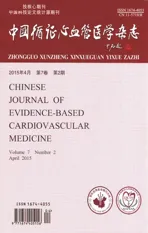经皮冠状动脉介入治疗急性冠脉综合征患者的临床疗效
2015-01-22徐桂冬李渊马雪兴姚金良陈璐韩震王熙
徐桂冬,李渊,马雪兴,姚金良,陈璐,韩震,王熙
• 论著 •
经皮冠状动脉介入治疗急性冠脉综合征患者的临床疗效
徐桂冬,李渊,马雪兴,姚金良,陈璐,韩震,王熙
目的回顾与总结经皮冠状动脉介入(PCI)治疗急性冠脉综合征(ACS)患者的临床疗效。方法选择2003年10月至2013年10月苏州市立医院北区心血管内科确诊的ACS患者543例。依据入院后手术日期分为急诊PCI组(n=236)和择期PCI组(n=307)。急诊PCI组中,老年组(≥60岁)124例,非老年组(42~59岁)112例;择期PCI组中,老年组(≥60岁)137例,非老年组(42~59岁)170例。收集患者的临床资料,包括穿刺成功率、手术成功率、手术总时间、术后并发症情况及出院后随访1年主要不良心血管事件发生情况等。结果急诊PCI组,老年组与非老年组性别比例、家族史比例、吸烟比例、心梗部位、罪犯血管、血脂、左室射血分数比较无统计学差异(P均>0.05)。老年组较非老年组,糖尿病、高血压比例增加,总胆固醇降低,差异有统计学意义(P均<0.05)。择期PCI组,老年组与非老年组性别比例、家族史比例、心梗部位、罪犯血管、血脂、左室射血分数比较,无统计学差异(P均>0.05)。老年组较非老年组,糖尿病、高血压、吸烟比例增加,差异有统计学意义(P均<0.05)。急诊PCI组以及择期PCI组,老年组与非老年组穿刺成功率、手术成功率、手术总时间、造影剂量、住院期间再次血运重建以及随访1年再次心梗、再次行血运重建术比较,无统计学差异(P均>0.05)。急诊PCI组,老年组较非老年组,住院期间死亡比例增加,随访1年死亡、心力衰竭增加,差异有统计学意义(P均<0.05)。结论PCI治疗是ACS有效的治疗手段,但其对老年ACS患者远期预后的影响仍需进一步探讨。
冠状动脉介入治疗;急性冠脉综合征;老年
近几年我国心血管病患者成上升趋势,急性冠脉综合症(ACS)老年人群发病率明显高于中青年[1-4],溶栓、经皮冠状动脉介入治疗(PCI)、外科血运重建术等再灌注治疗策略为此类患者的有效治疗手段。针对罪犯血管行血运
重建术,特别PCI治疗,可明显降低部分老年急性心肌梗死(AMI)患者住院期间的死亡率,改善近期临床预后[5,6]。本研究总结分析我院近几年ACS经PCI治疗患者住院资料及随访结果,报告如下。
1 资料和方法
1.1 研究对象和分组选择2003年10月至2013年10月于苏州市立医院北区心血管内科确诊的ACS患者543例。纳入标准:经心电图、心肌酶谱、肌钙蛋白检测明确诊断为不稳定心绞痛、急性ST段抬高型心肌梗死、急性非ST段抬高型心肌梗死的患者。排除标准:①心源性休克需要行主动脉球囊反搏治疗;②严重肝肾功能不全者;③患者本人及家属拒绝行PCI术者。依据入院后手术日期分为急诊PCI组(n=236)和择期PCI组(n=307)。急诊PCI组中,老年组(≥60岁)124例,非老年组(42~59岁)112例;择期PCI组中,老年组(≥60岁)137例,非老年组(42~59岁)170例。
1.2 方法所有患者术前口服波立维300 mg和阿司匹林300 mg,均经桡动脉或股动脉入路,桡动脉或股动脉穿刺处局部麻醉后,行选择性冠状动脉造影术,综合心电图定位诊断,确定犯罪血管,病变钙化较重者,行经皮冠状动脉球囊扩张术(PTCA)+支架植入术,钙化较轻者行支架植入术。经桡动脉入路者,术后立即拔出动脉鞘管,人工按压30 s,覆盖无菌纱布,桡动脉压迫器加压包扎,术后12 h如无渗血、穿刺口愈合良好则拆除压迫器。经股动脉入路,根据术中肝素使用剂量,决定拔管时间,拔管后按压穿刺部位伤口30 min,无活动性出血及渗血后,局部予弹力绷带加压包扎,下肢制动24 h,如无渗血、血肿、血管杂音,予拆除弹力绷带。术后监测生命体征、心电图、局部出血、血肿及其它并发症。
1.3 观察指标收集患者住院期间资料,包括性别、年龄、合并疾病以及血脂情况。记录穿刺成功率、PCI成功率、手术总时间、术后出血并发症、死亡等。
1.4 随访出院后随访1年,记录终点事件,包括:任何原因的死亡、再次心肌梗死、卒中、出血、靶血管再次血运重建情况。
1.5 统计学处理采用SPSS17.0软件进行统计学处理,计量资料采用均数±标准差(±s)表示,两组间均数的比较采用t检验,计数资料采用例数(构成比)表示,组间比较采用χ2检验。P<0.05为差异有统计学意义。
2 结果
2.1 患者基本资料急诊PCI组,老年组与非老年组性别比例、家族史比例、吸烟比例、心梗部位、罪犯血管、血脂、左室射血分数比较,无统计学差异(P均>0.05)。老年组较非老年组,糖尿病、高血压比例增加,总胆固醇降低,差异有统计学意义(P均<0.05)。择期PCI组,老年组与非老年组性别比例、家族史比例、心梗部位、罪犯血管、血脂、左室射血分数比较,无统计学差异(P均>0.05)。老年组较非老年组,糖尿病、高血压、吸烟比例增加,差异有统计学意义(P均<0.05)(表1)。
2.2 介入治疗观察指标结果急诊PCI组以及择期PCI组,老年组与非老年组穿刺成功率、手术成功率、手术总时间、造影剂量、住院期间再次血运重建以及随访1年再次心梗、再次行血运重建术比较,无统计学差异(P均>0.05)。急诊PCI组,老年组较非老年组,住院期间死亡比例增加,随访1年死亡、心力衰竭增加,差异有统计学意义(P均<0.05)(表2)。
3 讨论
老年人机体器官功能退化,发生了病理生理学改变,身体状况不同于年轻人群。溶栓为急性心肌梗死的早期有效治疗方法之一,但在老年群体,临床应用受到患者自身及医疗风险的限制,ACC/AHA指南中指出[7,8],溶栓只作为老年急性ST段抬高型心肌梗死无法立即行PCI治疗的替代方案,故PCI治疗为目前首选的治疗策略。国内外大量的研究表明[9],PCI术能明显降低ACS患者的死亡率,也有研究表现,PCI术在早期可降低老年ACS患者的死亡率及改善近期预后[10]。
本研究回顾性分析了我院近几年接受PCI治疗的ACS患者的住院资料及随访结果,研究结果显示,急诊PCI组以及择期PCI组,老年组与非老年组穿刺成功率、手术成功率、手术总时间、造影剂量、住院期间再次血运重建以及随访1年再次心梗、再次行血运重建术比较,无统计学差异(P均>0.05)。急诊PCI组,老年组较非老年组,住院期间死亡比例增加,随访1年死亡、心力衰竭增加,差异有统计学意义(P均<0.05)。PTCA研究荟萃分析了22项相关临床试验,老年ST段抬高型心肌梗死直接PCI优于溶栓治疗,但>75岁老年患者溶栓及>80岁老年患者接受直接PCI的获益由于并发症发生率高尚需进一步评估,并且非ST段抬高型心肌梗死和高危不稳定心绞痛老年患者早期介入治疗和早期保守治疗的选择目前仍有争议,合并心源性休克的高龄ACS患者,SHOCK亚组分析结果表明75岁以上患者预后差,早期血运重建后30 d的死亡率高于初
始药物治疗组,而初始药物治疗组的死亡率与年龄<75岁组相似。
老年ACS的发病率高,但其接受PCI治疗的风险及术中、术后并发症等发生率也明显增加。虽然,近年来ACS行PCI治疗技术日益精湛,器械更加精益、甚至个体化,但老年ACS的死亡率仍明显高于非老年患者。临床实践中发现,老年ACS患者合并2型糖尿病或存在潜在的高血糖,发病时心电图检查无特征性改变,漏诊或误诊率相对增高,同时相当部分患者合并有肺、脑、肾以及其他脏器的功能不全,发病时临床症状不典型,多表现为呼吸困难、神经精神症状、消化道症状,部分老年患者因神经系统退化痛觉不敏感、反应迟钝等因素导致了就诊延误,降低了再灌注带来的获益,严重影响了老年ACS患者再灌注治疗的预后[11-14]。
老年ACS患者逐年增加已成为了我国心血管医生必须面对的问题,这个特殊人群有多支血管病变多、严重复杂病变、弥漫病变、钙化病变、扭曲病变、慢性闭塞病变等特点,多合并有心功能不全、肾功能不全、外周血管病变等,故PCI风险也显著高于非老年患者,并且介入治疗的安全性、有效性现阶段仍缺乏循证医学证据[15],临床实践具体操作中仍需谨慎。本研究为回顾性研究,存在局限性,拟在以后更长时间的随访中观察老年ACS介入治疗的获益。
[1] 陈伟伟,高润霖. 中国心血管病报2013概要[J]. 中国循环杂志.2014,29(7):487-91.
[2] Alexander KP,Roe MT,Chen AY,et al. Evolution in cardiovascular care for elderly patients with non-ST-segment elevation acute coronary syndromes: results from the CRUSADE National Quality Improvement Initiative[J]. J Am Coll Cardiol,2005,46(8):1479-87.
[3] Goldberg RJ,McCormick D,Gurwitz JH,et al. Age-related trends in short- and long-term survival after acute myocardial infarction: a 20-year population-based perspective (1975-1995)[J]. Am J Cardiol, 1998,82(11):1311-7.[4] Mackay J,Mensah GA. The atlas of heart disease and stroke. Geneva: World Health Organization. 2004.
[5] Thygesen K,Alpert JS,White HD,et al. Universal definition of myocardial infarction[J]. Eur Heart J,2007,28(20):2525-38.
[6] DeWood MA,Spores J,Notske R,et al. Prevalence of total coronary occlusion during the early hours of transmural myocardial infarction[J]. N Engl J Med,1980,303(16):897-902.
[7] Antman EM,Hand M,Armstrong PW,et al. 2007 focused update of the ACC/AHA 2004 guidelines for the management of patients with ST-elevation myocardial infarction: a report of the American College of Cardiology/American Heart Association Task Force on Practice Guidelines[J]. J Am Coll Cardiol,2008,51(2):210-47.
[8] Berger AK,Radford MJ,Wang Y,et al. Thrombolytic therapy in older patients[J]. J Am Coll Cardiol,2000,36(2):366-74.
[9] Patel MR,Dehmer GJ,Hirshfeld JW,et al. ACCF/SCAI/STS/ AATS/AHA/ASNC 2009 Appropriateness Criteria for Coronary Revascularization: A Report of the American College of Cardiology Foundation Appropriateness Criteria Task Force, Society for Cardiovascular Angiography and Interventions, Society of Thoracic Surgeons, American Association for Thoracic Surgery, American Heart Association, and the American Society of Nuclear Cardiology: Endorsed by the American Society of Echocardiography, the Heart Failure Society of America, and the Society of Cardiovascular Computed Tomography[J]. Circulation,2009,119(9):1330-52.
[10] Bach RG,Cannon CP,Weintraub WS,et al. The effect of routine,early invasive management on outcome for elderly patients with non-ST-segment elevation acute coronary syndromes[J]. Ann Intern Med,2004,141(3):186-95.
[11] Brieger D,Eagle KA,Goodman SG,et al. Acute coronary syndromes without chest pain, an underdiagnosed and undertreated high-risk group: insights from the Global Registry of Acute Coronary Events[J]. Chest,2004,126(2):461-9.
[12] Canto JG,Shlipak MG,Rogers WJ,et al. Prevalence,clinical characteristic -cs,and mortality among patients with myocardial infarction presenting without chest pain[J]. JAMA,2000, 283(24):3223-9.
[13] Alexander KP,Newby LK,Cannon CP,et al. Acute coronary care in the elderly, part I: Non-ST-segment-elevation acute coronary syndromes: a scientific statement for healthcare professionals from the American Heart Association Council on Clinical Cardiology: in collaboration with the Society of Geriatric Cardiology[J]. Circulation,2 007,115(19):2549-69.
[14] Alexander KP,Newby LK,Armstrong PW,et al. Acute coronary care in the elderly, part II: ST-segment-elevation myocardial infarction: a scientific statement for healthcare professionals from the American Heart Association Council on Clinical Cardiology: in collaboration with the Society of Geriatric Cardiology[J].Circulation,2007,115(19):2 570-89.
[15] Gale CP,Cattle BA,Woolston A,et al. Resolving inequalities in care? Reduced mortality in the elderly after acute coronary syndromes. The Myocardial Ischaemia National Audit Project 2003-2010[J]. Eur Heart J,2012,33(5):630-9.
Curative effect of percutaneous coronary intervention in patients with acute coronary syndrome
XU Guidong*, LI Yuan, MA Xue-xing, YAO Jin-liang, CHEN Lu, HAN Zhen, WANG Xi.*Department of Cardiovasology, Suzhou Municipal Hospital, Suzhou 215004, China.
ObjectiveTo retrospect and summarize the curative effect of percutaneous coronary intervention (PCI) in patients with acute coronary syndrome (ACS).MethodsACS patients (n=543) were chosen from Oct. 2003 to Oct. 2013, and then divided into emergency PCI group (n=236) and selective PCI group (n=307). Emergency PCI group was divided again into elderly group 1 (aged≥60, n=124) and non-elderly group 1 (aged from 42 to 59, n=112), and selective PCI group was divided again into elderly group 2 (aged≥60, n=137) and non-elderly group 2 (aged from 42 to 59, n=170). The clinical data were collected from all patients including puncture success rate, PCI success rate, PCI total time, complications after PCI, and major adverse cardiovascular events (MACE) after 1-year follow-up.ResultsBetween elderly group 1 and non-elderly group 1, the percentages of sex, medical history and smoking, locations of myocardial infarction (MI), culprit vessels, blood fat and LVEF had no statistical difference (all P>0.05). The percentages of patients with diabetes and hypertension increased and total cholesterol (TC) level decreased in elderly group 1 compared with non-elderly group 1 (all P<0.05). Between elderly group 2 and nonelderly group 2, the percentages of sex and medical history, locations of MI, culprit vessels, blood fat and LVEF had no statistical difference (all P>0.05). The percentages of patients with diabetes, hypertension and smoking cases increased in elderly group 2 compared with non-elderly group 2 (all P<0.05). The comparison in puncture success rate, PCI success rate, PCI total time, contrast agent dosage, re-revascularization during hospitalization, and re-MI and revascularization procedure during 1-year follow-up had no statistical difference between elderly group 1 and non-elderly group 1 or between elderly group 2 and non-elderly group 2 (all P>0.05). The percentage of died cases, and mortality and heart failure during 1-year follow-up had statistical difference between elderly group 1 and non-elderly group 1 (all P<0.05).ConclusionPCI is an effective therapy for ACS, but its influence on long-term prognosis in elderly patients with ACS needs further discussion.
Percutaneous coronary intervention; Acute coronary syndrome; Elderly patients
R816.2
A
1674-4055(2015)02-0267-03
2014-12-04)
(责任编辑:姚雪莉)
215004 苏州,苏州市立医院北区心血管内科
李渊,E-mail:liyuan1596215@163.com
10.3969/j.1674-4055.2015.02.36
